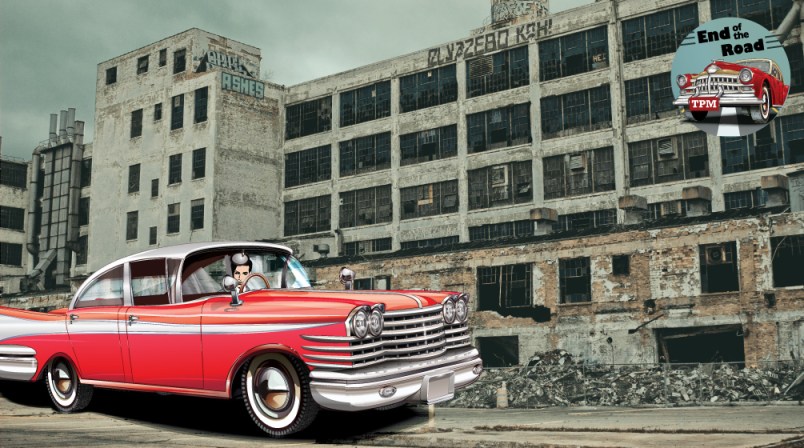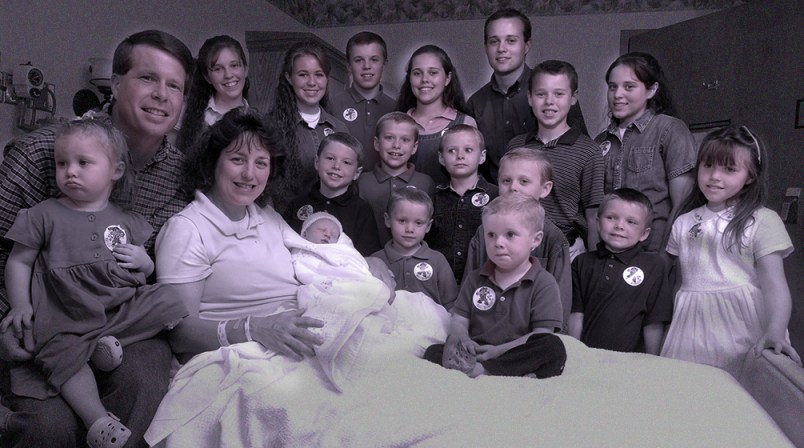This is part one of a four-part series at The Slice called “End of the Road,” about America’s waning love affair with car culture.
A few months ago, posters for Mad Men’s final season began to pop up in magazines and on bus stops. In one, Don Draper is sitting in a sun-dappled, slate-colored car—perhaps already driving, perhaps getting ready to drive, into the dawn of the 1970s. It’s the way we want to remember him: He has the same Brylcreem coif, same cigarette hanging carelessly from his fingers, same stoic stare and same furrowed brow. For a moment, we forget that beneath the artifice is the poor, terrified son of a prostitute. In this impossibly beautiful car, his hand on the wine-colored steering wheel, he’s every inch the sexy, fearless, dick-swinging man’s man, speeding toward the future’s endless possibilities.
Then there’s the tagline: “The End of an Era.” In a few weeks, Mad Men will come to an end. But this kind of man, and this kind of car, is already long gone—even if their imagery isn’t.
Cars have been symbols of unfettered, masculine individuality ever since Ford began to mass-produce the Model T in 1914. A car wasn’t just something a man needed, it completed him as a rough-and-tumble, red-blooded American. Since the mid-’50s, when the automobile industry became a buyer’s market and advertising exploded, car commercials have projected two versions of the American dream: the Norman Rockwell painting of domestic bliss, and the barely-blazed trail of male adventure.
But curiously, though times have changed, advertising strategies haven’t. Car ads have yet to reflect our age of scarcity and climate change, where Americans drive less, buy fewer cars, and get fewer drivers’ licenses. After the Great Recession, there have been murmurs about the end of America’s love affair with the automobile, but even before the downturn, this cultural shift was underway. Urbanists often draw attention to Millennials’ disinterest in car ownership; one study found that driving by young people decreased 23 percent between 2001 and 2009. Since its peak in 2005, the number of miles driven per person has been almost 9 percent lower. In the past few years, bike-sharing and car-sharing have been on the rise.
Yet amid this shift, advertisers have doubled down on the macho fantasy of the open road. Why, if cars have started to fall from grace, do ads continue to treat automobiles as the beacons of manly success as if nothing ever happened?

Since mass production, John Heitmann writes in The Automobile and American Life, the car has been imagined as a “freedom machine,” a horizon to which we aspire. The most well-known car ad of the 1920s, for the Jordan Playboy, made an almost heavenly promise:
Somewhere far beyond the place where men and women and motors race through the canyons of the town — somewhere on the top of the world — there is a peak which dull car has never climbed. You can go there lighthearted in a Jordan Playboy — for it’s always happy in the hills.
The car was about the sheer marvel of mobility—not just in terms of space, but class. Early ads showed effete men and women “posing in their swanky flapper dresses, trying to be read as upper class,” says Catherine Gudis, a history professor at UC-Riverside and author of Buyways: Billboards, Automobiles, and the American Landscape. They projected “a different kind of effortlessness” matching their newly elite status, an image that isn’t “nearly as aggressively masculine” as in later car ads.
In the 1930s and ‘40s, our belts tightened, but car sales stayed healthy. And the symbolism was still intact: Cars were about “making your own way in the world,” Gudis says, about retaining your dignity even as the rest of your life crumbles around you.
In the postwar period, when money, highways and white picket fences abounded, car ads positioned their products smack-dab in an American fantasyland. But there was a stark gender split. Ads depicted women as hapless passengers or dutiful housewives shopping for groceries and shuttling kids around.
When a woman was in a car, she wasn’t reveling in the pleasures of the open road. She wasn’t suave and powerful. She was…well, what the majority of America is now: mired in a highway-choked suburb, hopelessly dependent on her “freedom machine.”
Of course, the more exciting ads blithely ignored this irony. When men were in cars solo, they were cowboys. They were enigmatic and charismatic, unshackled from rote domesticity. In 1964, the Buick Riviera introduced a car that “only a man can really understand.” The voiceover promised that “adventure begins here and never ends.”
In 1966, Mercury even employed a frontier mystique to sell a dorky station wagon: “Better ideas make a better wagon,” it proclaimed. “A Man’s wagon.” Suddenly, it wasn’t about cramming your wife and kids’ crap into the hatch for a family road trip. The “wagon” is rustic, gritty—almost primal.
Even as the women’s movement reverberated in the 1970s, car companies coasted along unfazed. Actually, the invocation of sex to sell cars went into overdrive. Google “sexist car ad” and you’ll be greeted by a vintage campaign from 1973, the peak year for car sales in the United States: The Subaru GL Coupe was “like a spirited woman who yearns to be tamed.” The driver is “a man who grabs life by the cuff…You live life your way….Sleek…Agile…Now. Turn her on.”

“It’s not surprising that pop culture would try to fortify something they’re losing, and that they would do it through consumer culture,” Gudis says. Just as women were gaining some ground, and the U.S.’s global dominance was coming into question, “you see very overt examples of manliness,” a sense that Americans “can still do whatever we want.”
Through America’s economic ebbs and flows of the next few decades, car sales remained constant, and so did their advertising strategies. 1987: “If your head hasn’t already convinced you to choose the SAAB 9000…try consulting another part of your anatomy.” 1997: Chevy billed their Monte Carlo as “a mute button…for reality.” The road was still a place where a man could escape—or at least pick up a woman to have sex with.

Then the recession happened at the tail end of 2007. Men got laid off in droves, prompting neologisms like “mancession” and the declaration of “The End of Men.” The government bailed out GM, and Detroit retreated further into post-industrial squalor. Gas prices soared in the summer of 2008, and although they’re mercifully low at the moment, they’re still a budgetary concern in a way they weren’t a decade ago. Car sales numbers dipped to less than half of what they were at their peak in the ‘70s.
Yet, paradoxically, most of non-coastal America is just as dependent on cars as ever. In many cities—and certainly in every suburb and rural area—having a car is the key to accessing employment, food, schools and friends. To some Americans, it’s been that way forever. “The love affair which was always touted heavily [in ads] may not have existed to the extent that some people believe,” says John Heitmann. “To the everyday American lower-middle class blue collar worker, the car was utility, a way to get to work.”
Nowadays, most of us feel this way, especially when we’re saddled with car payments and gas bills. Automobiles have always been sold as little declarations of independence, but for the modern American family, they’ve become necessary evils—our collective ball-and-chain.
You wouldn’t know all this by the car ads punctuating basketball games and late-night television. Despite a creeping anti-car sea change, and the fact that female drivers now outnumber their male counterparts, marketing strategies in the United States have changed surprisingly little. It’s not that car companies haven’t noticed the shift. They know a certain sect of America would rather fetishize the newest smartphone or Apple watch. But they still have to sell cars, and they also know a big chunk of the country—where manliness is prized and global warming is a myth—still hankers for a bygone era. For this America, they proffer strong, silent Gary Cooper types just trying to steal some peace on an empty highway. (Women, of course, are stuck wearing pastels and wrangling rowdy children.)
These commercials are often little more than real-life renderings of this season’s Mad Men ads. Matthew McConaughey, the nation’s cowboy laureate and Lincoln’s current spokesman, has spent the last seven months looking weathered and wistful on vast Western stretches of road. In his inaugural ad, Lincoln had him pitch us its product by touting the past—quite literally: “Sometimes you gotta go back to actually go forward…to where you came from…where you been,” he drawls. “I know there are those that say you can’t go back. Yes, you can.” A hybrid, McConaughey assures us, is “not about huggin’ trees”; it’s about a far sexier “sweet spot.” America may be getting older, but our car ads stay the same age.
Even Detroit, GM swears, isn’t doing as badly as you’ve heard. In 2011, Eminem—a kinetic ball of dudely energy if there ever was one—cruised around in a Chrysler in the longest Superbowl commercial ever aired. “What does a town that’s been through hell and back know about the finer things in life?” a gravely voice asks, as the camera weaves through the Motor City’s landmarks and murals, its still-shiny sculpture of a defiant fist. “Well, I’ll tell ya: more than most.” It’s not that the ads aren’t acknowledging change; they’re just reassuring us of good old American resilience.
Mercedez-Benz, that enduring symbol of luxury, took the nostalgia-fest to its logical conclusion: They snagged the voice of Don Draper himself, Jon Hamm. Car companies are squeezing out what’s left of masculine paradigms, banking on our need to tap into a less complicated past. But eventually, they may find themselves left in the dust.






